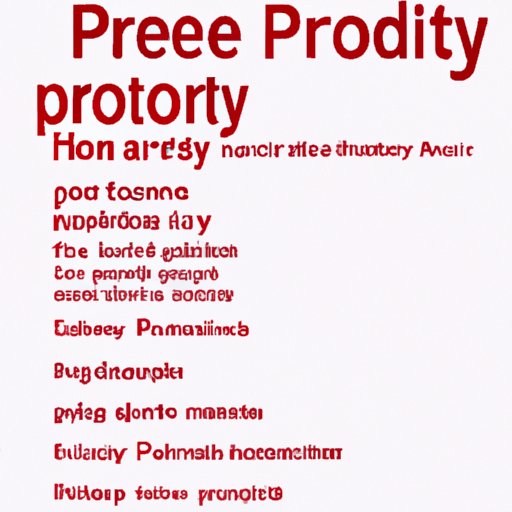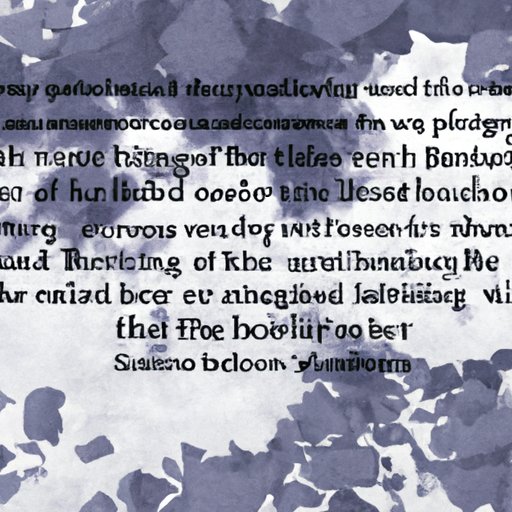
Introduction
Free verse poetry is a form of expression that has gained popularity in recent years. Unlike traditional forms of poetry, free verse does not follow strict rules regarding rhyme and meter. Instead, it allows poets to experiment with structure and language, resulting in unique and expressive works. In this article, we will explore several free verse poem examples, examining their structure, themes, and imagery. By analyzing these poems, we hope to gain a deeper understanding of the beauty and power of free verse poetry.
An Introduction to Free Verse Poetry: Analysis of an Example
To begin our exploration of free verse poetry, let’s take a look at a well-known and widely-anthologized poem. “The Love Song of J. Alfred Prufrock” by T.S. Eliot is a classic example of free verse poetry. The poem contains no rhyming scheme, and the lines have varying lengths and rhythms.
The poem’s form contributes to its meaning by reflecting the fragmented and disjointed thoughts of its protagonist, J. Alfred Prufrock. The lack of a traditional structure allows Eliot to experiment with the speaker’s stream of consciousness, offering insight into his anxiety, insecurity, and isolation.
The poem’s themes and imagery center around the idea of time and the human condition. Eliot uses vivid metaphors and symbols to show how time can both empower and diminish us, and how we are all consumed by the same fears and doubts.
The Art of Writing Free Verse Poems: A Case Study
Now, let’s examine a free verse poem by a lesser-known poet. “Leaves” by Gabrielle Calvocoressi is a beautiful example of how poets can create structure without rhyme and meter. The poem is divided into stanzas of varying lengths, each with its own internal rhythm and flow.
Calvocoressi’s approach to writing free verse is unique and inventive, using line breaks and enjambment to create tension and meaning. The poem’s themes and imagery explore nature, growth, and loss, capturing the beauty and fragility of life.

Breaking the Boundaries: A Free Verse Poem Example
Some poets use free verse to subvert traditional expectations of form and content. “The Waste Land” by T.S. Eliot is an example of this kind of experimentation. The poem is a complex and fragmented work that challenges the reader’s understanding of structure and meaning.
Eliot’s use of free verse enhances the poem’s meaning by reflecting the disordered and unpredictable nature of life. The poem’s themes and imagery explore the breakdown of society, the loss of identity, and the search for meaning in a world that seems chaotic and senseless.
Capturing Emotions: An Analysis of a Free Verse Poem
Free verse poetry can capture complex emotions in a way that traditional poetry cannot. “Funeral Blues” by W.H. Auden is a powerful and poignant example of this kind of poetry. The poem’s form and content work together to capture the speaker’s grief and mourning.
Auden’s use of repetition and extended metaphor enhances the poem’s meaning by emphasizing the speaker’s loss and despair. The poem’s themes and imagery explore the universality of grief and the pain of losing someone you love.
An Insight into Free Verse: The Structure and Meaning of an Example
Free verse can be used to create a unique structure that contributes to a poem’s meaning. “One Art” by Elizabeth Bishop is an example of how poets can use repetition and enjambment to create structure and enhance meaning.
The poem’s form reflects the speaker’s attempt to control her losses and failures, using repeated lines and broken syntax to capture the tension and frustration she feels. The poem’s themes and imagery explore the idea of loss and how we come to terms with it.
Experimenting with Free Verse: A Poem Analysis
Poets can use free verse to experiment with form, creating works that challenge traditional understandings of poetry. “Spleen” by Charles Baudelaire is an example of this kind of experimentation. The poem uses a fragmented structure and abrupt shifts in tone and image to create a sense of disorientation and unease.
Baudelaire’s use of free verse enhances the poem’s meaning by reflecting the speaker’s sense of isolation and despair. The poem’s themes and imagery explore the darker aspects of human existence, including pain, suffering, and decay.
The Power of Free Verse: An Analysis of a Contemporary Poem
Free verse poetry is a powerful form of expression that remains relevant in contemporary times. “When I Grow Up I Want to Be a List of Further Possibilities” by Chen Chen is an example of a contemporary free verse poem that captures the complexities of identity, love, and family.
The poem’s form and content work together to create a sense of fragmentation and uncertainty, reflecting the speaker’s struggle to find his place in the world. The poem’s themes and imagery explore the challenges of growing up, coming out, and finding acceptance in a world that can be both beautiful and cruel.
Conclusion
In conclusion, free verse poetry is a rich and varied form of expression that allows poets to experiment with form, structure, and language. By analyzing several free verse poem examples, we have gained insight into the unique ways that free verse can enhance meaning and capture complex emotions and themes. We hope that this article has inspired you to explore more free verse poetry and discover its beauty and power as a form of expression.





